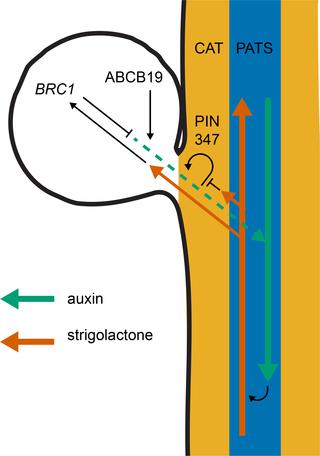PLOS Genetics ( IF 4.0 ) Pub Date : 2019-03-13 , DOI: 10.1371/journal.pgen.1008023 Martin van Rongen , Tom Bennett , Fabrizio Ticchiarelli , Ottoline Leyser

|
The shoot systems of plants are built by the action of the primary shoot apical meristem, established during embryogenesis. In the axil of each leaf produced by the primary meristem, secondary axillary shoot apical meristems are established. The dynamic regulation of the activity of these axillary meristems gives shoot systems their extraordinary plasticity of form. The ability of plants to activate or repress these axillary meristems appropriately requires communication between meristems that is environmentally sensitive. The transport network of the plant hormone auxin has long been implicated as a central player in this tuneable communication system, with other systemically mobile hormones, such as strigolactone and cytokinin, acting in part by modulating auxin transport. Until recently, the polar auxin transport stream, which provides a high conductance auxin transport route down stems dominated by the auxin export protein PIN-FORMED1 (PIN1), has been the focus for understanding long range auxin transport in the shoot. However, recently additional auxin exporters with important roles in the shoot have been identified, including PIN3, PIN4 and PIN7. These proteins contribute to a wider less polar stem auxin transport regime, which we have termed connective auxin transport (CAT), because of its role in communication across the shoot system. Here we present a genetic analysis of the role of CAT in shoot branching. We demonstrate that in Arabidopsis, CAT plays an important role in strigolactone-mediated shoot branching control, with the triple pin3pin4pin7 mutant able to suppress partially the highly branched phenotype of strigolactone deficient mutants. In contrast, the branchy phenotype of mutants lacking the axillary meristem-expressed transcription factor, BRANCHED1 (BRC1) is unaffected by pin3pin4pin7. We further demonstrate that mutation in the ABCB19 auxin export protein, which like PIN3 PIN4 and PIN7 is widely expressed in stems, has very different effects, implicating ABCB19 in auxin loading at axillary bud apices.
中文翻译:

生长素的结缔运输独立于转录因子BRC1有助于strigolactone介导的芽分支控制
植物的芽系统是通过在胚发生过程中建立的初级芽顶端分生组织的作用而建立的。在由原生分生组织产生的每片叶子的腋中,建立了次生腋生芽顶生分生组织。这些腋生分生组织的活动的动态调节使芽系统具有非凡的可塑性。植物适当地激活或抑制这些腋生分生组织的能力要求对环境敏感的分生组织之间进行交流。长期以来,人们一直认为植物激素植物生长素的运输网络是这种可调节通讯系统的核心参与者,其他全身移动性激素,例如strigolactone和cytokinin,部分地通过调节植物生长素的运输来发挥作用。直到最近,极性植物生长素运输流 它提供了高电导的植物生长素运输途径,向下延伸至以植物生长素出口蛋白PIN-FORMED1(PIN1)为主导的茎,一直是了解芽中植物生长素长期运输的重点。但是,最近发现了在芽中具有重要作用的其他生长素出口商,包括PIN3,PIN4和PIN7。这些蛋白质促进了更宽的极性较小的植物生长素运输机制,我们将其称为结缔性植物生长素运输(CAT),因为它在整个芽系统中起着沟通的作用。在这里,我们介绍了CAT在枝条分支中的作用的遗传分析。我们证明,在拟南芥中,CAT在strigolactone介导的芽分支控制中起着重要的作用,三倍 一直是了解芽中远距离生长素运输的重点。但是,最近发现了在芽中具有重要作用的其他生长素出口商,包括PIN3,PIN4和PIN7。这些蛋白质促进了更宽的极性较小的植物生长素运输机制,我们将其称为结缔性植物生长素运输(CAT),因为它在整个芽系统中起着沟通的作用。在这里,我们介绍了CAT在枝条分支中的作用的遗传分析。我们证明,在拟南芥中,CAT在strigolactone介导的芽分支控制中起着重要的作用,三倍 一直是了解芽中远距离生长素运输的重点。但是,最近已经确定了在芽中具有重要作用的其他生长素出口商,包括PIN3,PIN4和PIN7。这些蛋白质促进了更宽的极性较小的植物生长素运输机制,我们将其称为结缔性植物生长素运输(CAT),因为它在整个芽系统中起着沟通的作用。在这里,我们介绍了CAT在枝条分支中的作用的遗传分析。我们证明,在拟南芥中,CAT在strigolactone介导的芽分支控制中起着重要的作用,三倍 这些蛋白质促进了更宽的极性较小的植物生长素转运机制,我们将其称为结缔性植物生长素转运(CAT),因为它在整个芽系统的通讯中发挥了作用。在这里,我们介绍了CAT在芽分支中的作用的遗传分析。我们证明,在拟南芥中,CAT在strigolactone介导的芽分支控制中起着重要的作用,三倍 这些蛋白质促进了更宽的极性较小的植物生长素运输机制,我们将其称为结缔性植物生长素运输(CAT),因为它在整个芽系统中起着沟通的作用。在这里,我们介绍了CAT在枝条分支中的作用的遗传分析。我们证明,在拟南芥中,CAT在strigolactone介导的芽分支控制中起着重要的作用,三倍pin3pin4pin7突变体能够部分抑制strigolactone缺陷突变体的高度分支表型。相反,缺少腋分生组织表达的转录因子BRANCHED1(BRC1)的突变体的分支表型不受pin3pin4pin7的影响。我们进一步证明,ABCB19生长素输出蛋白中的突变(如PIN3 PIN4和PIN7在茎中广泛表达)具有非常不同的作用,这意味着ABCB19参与腋芽芽的生长素负载。











































 京公网安备 11010802027423号
京公网安备 11010802027423号